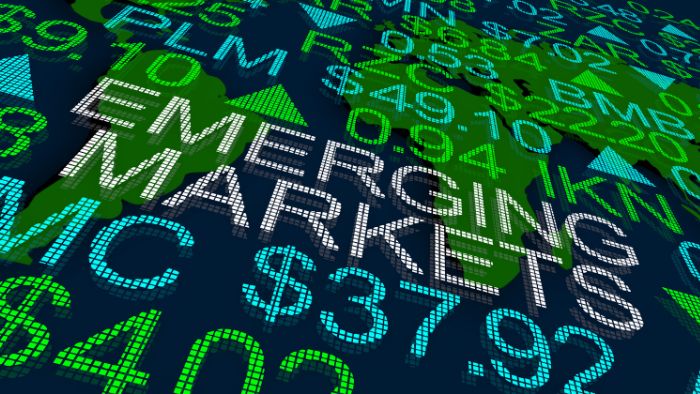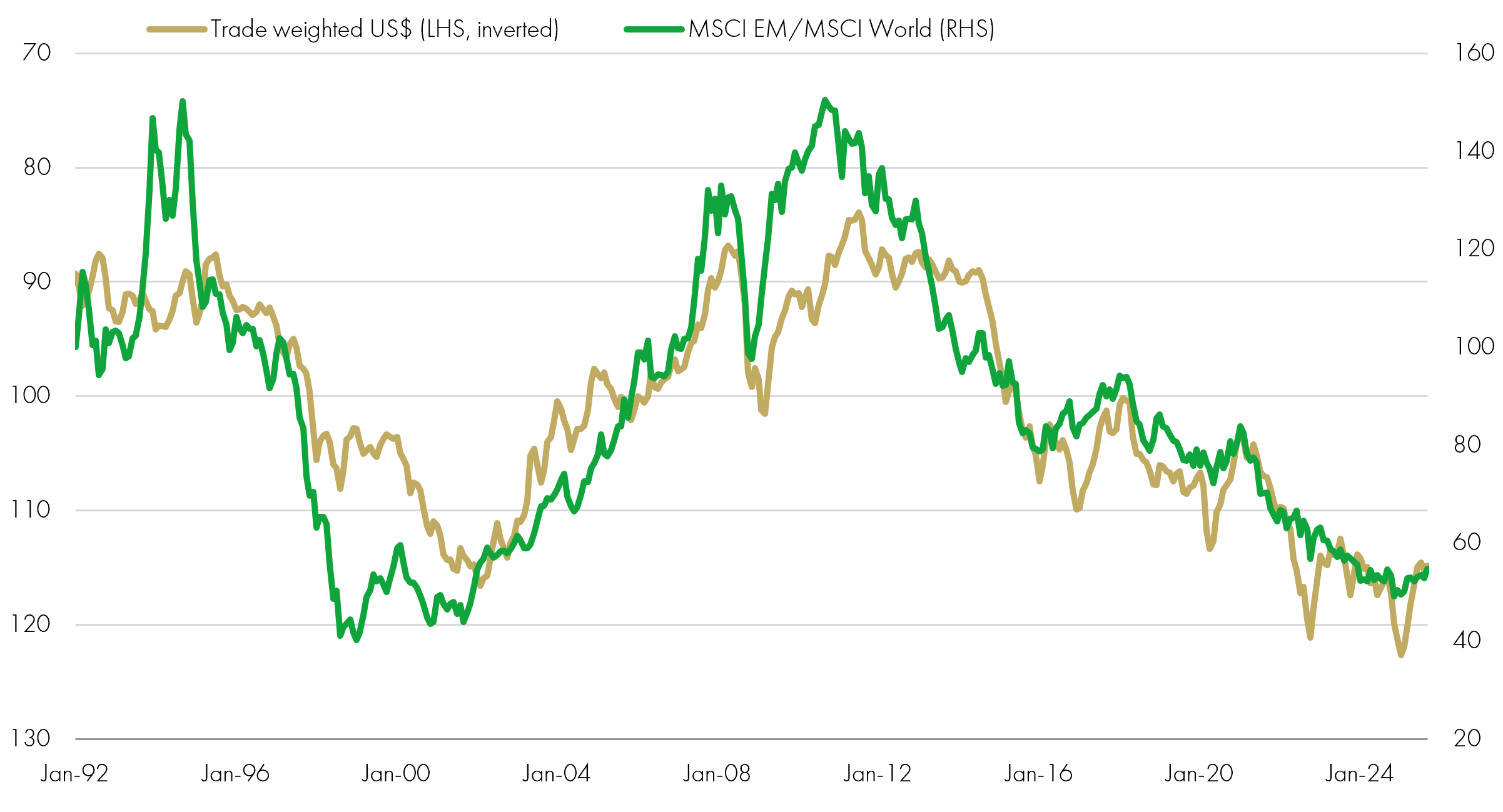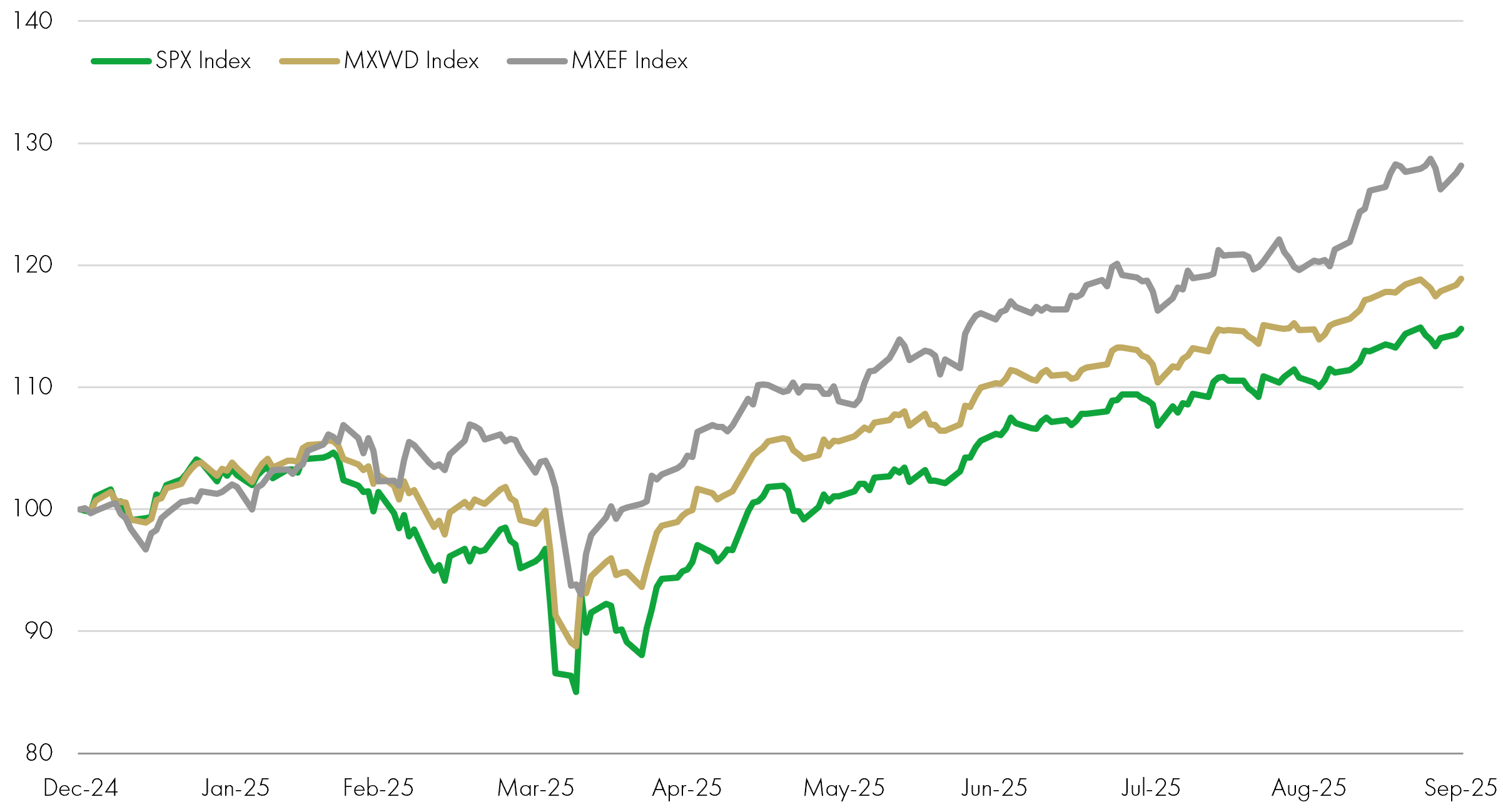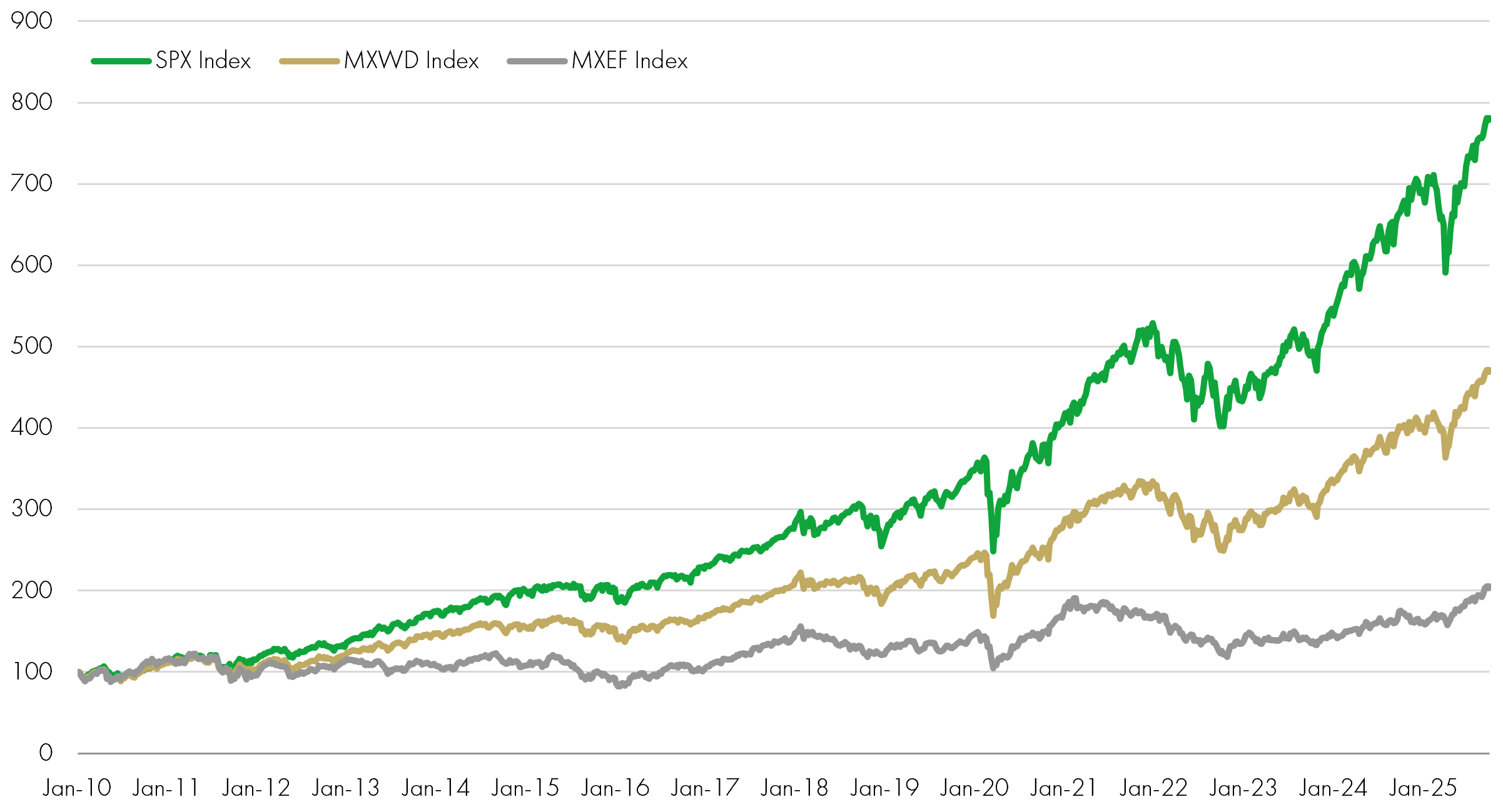
Past performance does not predict future returns. You may get back less than you originally invested. Reference to specific securities is not intended as a recommendation to purchase or sell any investment.
This article is featured in the Q3 2025 Future Strategist newsletter, you can read the rest of the newsletter here.
With the broad US dollar down 10% so far this year and some emerging market currencies up significantly (Brazilian real is +16% while the Polish zloty and Mexican peso are +14%), are we in the early stages of a new cycle for emerging markets assets?

A weaker dollar does not just ease pressure on emerging markets, it unlocks investment. FX relief lowers external funding costs, attracts capital flows, cheapens US dollar-priced technology, improves terms of trade for many exporters and cools imported inflation. Together, these forces expand fiscal and corporate bandwidth to build the infrastructure, skills and supply chains needed for AI, electrification and a rewired global economy.
Emerging market assets have tended to do better in dollar-weakening phases as global financial conditions loosen, risk appetite improves and the cost of servicing dollar liabilities falls. The Bank for International Settlements (BIS) finds that the level of the dollar is a strong driver of emerging market capital flows, especially into local-currency assets, over and above traditional risk proxies (global financial conditions or bond/equity volatility).
A softer dollar helps in a number of ways: it tightens emerging market risk premia and attracts flows; lowers prices for US dollar-invoiced capital goods and services; typically aligns with firmer commodity prices that aid many emerging market exporters; and it lowers imported inflation, allowing central banks to ease monetary policy. This all frees up balance sheet and policy space to invest in AI, the energy transition, supply-chain diversification and digital finance.
Trade-weighted US$ versus MSCI EM/DM relative performance

Source: Federal Reserve, Bloomberg, as at 30 September 2025. Past performance does not predict future returns.
The dollar is also a powerful risk-taking thermostat. BIS shows that a weaker US dollar boosts local-currency bond and equity flows to emerging markets; 2025 has seen renewed emerging market portfolio inflows, with August marking the strongest month in nearly a year. Capital inflows and tighter credit spreads reduce the hurdle rate for new economy projects such as data centres, fintech rails and EV supply chains, crowding capital towards growth.
Dollar depreciation also lowers global import prices for US dollar-invoiced goods and services. Things like robotics, semiconductor tools, industrial software and cloud services are commonly priced or benchmarked in dollars and become more affordable to emerging market buyers as the dollar falls. These lower prices accelerate diffusion of AI infrastructure (graphics processing units (GPUs)/servers), factory automation and grid technologies.
Historically, commodity prices have moved inversely to the dollar, boosting terms of trade and fiscal receipts of emerging market exporters when the dollar softens (the Covid pandemic is a notable exception). Strong commodity revenues can fund green capex (transmission lines and renewables), processing upgrades and downstream value-add such as battery materials.
Finally, a weaker dollar reduces imported inflation into emerging market economies. Lower inflation gives central banks room to cut interest rates, supporting domestic demand. After successfully taming inflation, many central banks began easing monetary policy ahead of the Fed.
We are already seeing many of these benefits begin to play out. India’s data centre capacity is expected to grow from 1 gigawatt (GW) in 2024 to 1.8GW by 2027, and potentially as high as 8GW by 2030 – a path made easier when US dollar prices of imported servers, networking and power systems are more favourable. Indonesia is accelerating a nickel-to-battery ecosystem, inaugurating an integrated EV battery project in June and clinching a trade deal with the EU that could channel more investment into downstream processing.
Mexico continues to attract new foreign direct investment (FDI) into manufacturing, leveraging its proximity to US demand and a highly competitive manufacturing sector. Historically dominated by the automotive sector, electronics is benefiting from supply chain diversification away from Asia, Mexico has overtaken China as the US’s top supplier of medical devices, and aerospace capacity is also expanding. Vietnam’s electronics exports are approaching $70 billion for the year to August, up more than 40% year on year, and the country is adding semiconductor back-end capacity with targeted incentives. As US dollar-priced robotics and machine tools get cheaper, emerging market manufacturers can step up automation and packaging/testing in semis, enabling them to climb the value chain.
India’s digital public infrastructure (UPI/ONDC/Aadhaar) has scaled to mass usage – UPI processed a record 650 million transactions a day in August – lowering cash friction and enabling new business models at the last mile.
Brazil offers another success story: PIX, the central bank’s instant payments rail, is now the country’s most popular channel with two-thirds of Brazilians using PIX at least monthly in 2024. New features such as PIX Automatico (recurring payments, June 2025) and PIX Parcelado (instalments, fourth quarter of 2025) deepen merchant acceptance and subscription use cases, especially for consumers without credit cards. In a weaker US dollar environment, both ecosystems benefit from cheaper cloud, security and hardware, plus easier funding conditions – accelerating inclusion and fintech innovation across credit, payments and embedded finance.
Returning to more traditional economic needs, emerging markets have significant infrastructure deficits, with needs spanning power, transport, water/sanitation and digital networks. Many of the products required are priced in dollars, from turbines, transformers and high-voltage equipment to rolling stock and robotics, making these products more affordable, improving project returns and access to financing. Improved infrastructure has immense benefits to the underlying economy, from higher potential growth and productivity, the crowding in of private investment and jobs to fewer bottlenecks easing supply-side inflation, energy security and, ultimately, better fiscal risk profiles.
A softer dollar is not a guarantee of emerging market outperformance. Idiosyncratic risks such as politics, governance or weather/climate events can override the US dollar impulse. But dollar down-cycles historically open a window for emerging markets to invest, raising the probability that governments and corporates convert FX relief into assets, people and products across AI infrastructure, EV and grid build-outs, diversified supply chains and digital finance. The dollar can provide a meaningful tailwind to emerging market economies and assets, but execution on innovation capex will remain key to fully taking advantage.
Emerging market equities have had a strong year, returning +28.2% to the end of September, more than 10 percentage points ahead of developed markets’ +17.9% return ($). Given the scale of the underperformance recorded over the past 15 years, it could be that we are in the very early stages of a new cycle for emerging markets assets.
S&P 500, MSCI World, MSCI EM – year to date (US$, total returns, gross dividends)

Source: Bloomberg, 31 December 2024 to 30 September 2025. Past performance does not predict future returns.
S&P 500, MSCI World, MSCI EM – 2010 to 2025 (US$, total returns, gross dividends)

Source: Bloomberg, 8 January 2010 to 30 September 2025. Past performance does not predict future returns.
Read, watch and listen to more insights from Liontrust fund managers here >
KEY RISKS
Past performance does not predict future returns. You may get back less than you originally invested.
We recommend this fund is held long term (minimum period of 5 years). We recommend that you hold this fund as part of a diversified portfolio of investments.
The Funds managed by the Global Equities team:
- May hold overseas investments that may carry a higher currency risk. They are valued by reference to their local currency which may move up or down when compared to the currency of a Fund.
- May encounter liquidity constraints from time to time. The spread between the price you buy and sell shares will reflect the less liquid nature of the underlying holdings.
- May invest in smaller companies and may invest a small proportion (less than 10%) of the Fund in unlisted securities. There may be liquidity constraints in these securities from time to time, i.e. in certain circumstances, the fund may not be able to sell a position for full value or at all in the short term. This may affect performance and could cause the fund to defer or suspend redemptions of its shares.
- May have a concentrated portfolio, i.e. hold a limited number of investments or have significant sector or factor exposures. If one of these investments or sectors / factors fall in value this can have a greater impact on the Fund's value than if it held a larger number of investments across a more diversified portfolio.
- May invest in emerging markets which carries a higher risk than investment in more developed countries. This may result in higher volatility and larger drops in the value of a fund over the short term.
- Certain countries have a higher risk of the imposition of financial and economic sanctions on them which may have a significant economic impact on any company operating, or based, in these countries and their ability to trade as normal. Any such sanctions may cause the value of the investments in the fund to fall significantly and may result in liquidity issues which could prevent the fund from meeting redemptions.
- May invest in companies predominantly in a single country which maybe subject to greater political, social and economic risks which could result in greater volatility than investments in more broadly diversified funds.
- May hold Bonds. Bonds are affected by changes in interest rates and their value and the income they generate can rise or fall as a result; The creditworthiness of a bond issuer may also affect that bond's value. Bonds that produce a higher level of income usually also carry greater risk as such bond issuers may have difficulty in paying their debts. The value of a bond would be significantly affected if the issuer either refused to pay or was unable to pay.
- May, under certain circumstances, invest in derivatives, but it is not intended that their use will materially affect volatility. Derivatives are used to protect against currencies, credit and interest rate moves or for investment purposes. There is a risk that losses could be made on derivative positions or that the counterparties could fail to complete on transactions. The use of derivatives may create leverage or gearing resulting in potentially greater volatility or fluctuations in the net asset value of the Fund. A relatively small movement in the value of a derivative's underlying investment may have a larger impact, positive or negative, on the value of a fund than if the underlying investment was held instead. The use of derivative instruments that may result in higher cash levels. Cash may be deposited with several credit counterparties (e.g. international banks) or in short-dated bonds. A credit risk arises should one or more of these counterparties be unable to return the deposited cash.
The risks detailed above are reflective of the full range of Funds managed by the Global Equities team and not all of the risks listed are applicable to each individual Fund. For the risks associated with an individual Fund, please refer to its Key Investor Information Document (KIID)/PRIIP KID.
The issue of units/shares in Liontrust Funds may be subject to an initial charge, which will have an impact on the realisable value of the investment, particularly in the short term. Investments should always be considered as long term.
DISCLAIMER
This material is issued by Liontrust Investment Partners LLP (2 Savoy Court, London WC2R 0EZ), authorised and regulated in the UK by the Financial Conduct Authority (FRN 518552) to undertake regulated investment business.
It should not be construed as advice for investment in any product or security mentioned, an offer to buy or sell units/shares of Funds mentioned, or a solicitation to purchase securities in any company or investment product. Examples of stocks are provided for general information only to demonstrate our investment philosophy. The investment being promoted is for units in a fund, not directly in the underlying assets.
This information and analysis is believed to be accurate at the time of publication, but is subject to change without notice. Whilst care has been taken in compiling the content, no representation or warranty is given, whether express or implied, by Liontrust as to its accuracy or completeness, including for external sources (which may have been used) which have not been verified.
This is a marketing communication. Before making an investment, you should read the relevant Prospectus and the Key Investor Information Document (KIID) and/or PRIIP/KID, which provide full product details including investment charges and risks. These documents can be obtained, free of charge, from www.liontrust.com or direct from Liontrust. If you are not a professional investor please consult a regulated financial adviser regarding the suitability of such an investment for you and your personal circumstances.





